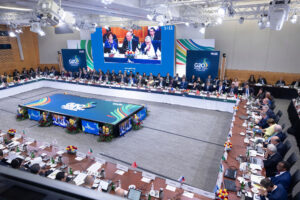The 29th Conference of the Parties (COP29) to the United Nations Framework Convention on Climate Change (UNFCCC), held last year in Baku, Azerbaijan, marked another milestone in the international climate negotiation process. Building on the agreement reached at COP28 in Dubai to transition away from fossil fuels, COP29 provided an opportunity to prepare for COP30 in Belém, Brazil, where countries are expected to discuss their updated Nationally Determined Contributions (NDCs) for 2035.
Climate finance continues to be a central theme in the international debate. The main outcome of COP29 was the adoption of the New Collective Quantified Goal (NCQG), through which countries committed to mobilise at least $300 billion annually to support developing countries in addressing climate change. This commitment was accompanied by the establishment of the Baku-Belém Roadmap, aiming to foster international cooperation for a significant increase of financial resources, from both public and private sources, to be directed towards developing countries.
The goal of the Baku to Belém Roadmap to 1.3T
The goal of the ‘Baku to Belém Roadmap to 1.3T’ is to scale up climate finance for developing countries, aiming to mobilise at least $1.3 trillion per year by 2035. The Roadmap is designed to support low greenhouse gas emission and climate-resilient development pathways, and to implement NDCs and national adaptation plans. It seeks to address the financial needs of developing countries, particularly those most vulnerable to climate change, by providing grants, concessional finance and non-debt-generating instruments. The Roadmap is guided by the current Azeri and incoming Brazilian presidencies and involves consultation with the Parties.
How is it linked to the NCQG agreed last year at COP29?
The outcome of the NCQG on climate finance included two main financial targets:
- $1.3 Trillion per year by 2035: The NCQG aims to mobilise at least $1.3 trillion per year by 2035 from all public and private sources. This target is in line with estimates from the UN Independent High-Level Expert Group on Climate Finance and is intended to support developing countries in their climate action efforts, including the implementation of NDCs and national adaptation plans.
- $300 Billion per year by 2035: Developed countries are expected to take the lead in mobilising at least $300 billion per year by 2035 for developing countries. This financial support should come from a diverse range of sources, including public and private entities, bilateral and multilateral organisations, and other innovative sources. Unlike the previous 100 billion goal, this new target includes all climate-related outflows and climate-related finance mobilised by multilateral development banks (MDBs), both from developed and developing countries. Additionally, developing countries have the option to contribute on a voluntary basis, including through South-South cooperation.
The link with Article 2.1(c) of the Paris Agreement
Article 2.1(c) of the Paris Agreement focuses on aligning financial flows with pathways towards low greenhouse gas emissions and climate-resilient development. The Roadmap’s goal of increasing climate finance to $1.3 trillion per year by 2035 directly supports the transformation of financial flows required by Article 2.1(c).
While Article 2.1(c) emphasises the overall change in global financial flows and the Roadmap focuses on increasing funding for developing countries, the two are intrinsically linked. Significant progress in one reinforces the other, as a substantial increase in funding for developing countries cannot take place without a broader alignment of financial flows with low-emission and climate-resilient development.
The main challenges in achieving the Roadmap’s objective
Achieving the goal of the Baku to Belém Roadmap is hindered by a complex set of challenges rooted in both systemic and structural issues. These include the high cost of capital, limited fiscal space and persistent debt burdens, all of which constrain the ability of developing countries to attract and absorb climate finance.
Private finance remains insufficient, especially for adaptation and in low-income countries, due to perceived investment risks, regulatory constraints and low returns, while public finance is under pressure from shrinking development budgets and competing domestic demands. Institutional weaknesses, lack of technical capacity and inconsistent policy frameworks at the country level further impede implementation.
Broader international dynamics, such as global financial regulations, trade agreements and credit rating practices, also limit the flow of finance to where it is most needed. These challenges are compounded by difficulties in measuring progress, ensuring transparency and aligning diverse stakeholders around a shared vision, all within a politically and economically uncertain global environment.
What elements should be considered as part of the Roadmap?
The Roadmap should incorporate a comprehensive set of elements that reflect both the scale of ambition and the complexity of mobilising USD 1.3 trillion per year by 2035. As highlighted in our submission, elements to be considered could include:
- Enhancing climate finance vehicles, particularly through deeper collaboration between National Development Banks (NDBs) and MDBs, and Vertical Climate and Environmental Funds.
- Deploying instruments to facilitate investments, including guarantees, foreign exchange risk instruments and leveraging carbon markets.
- Debt and fiscal tools, such as debt management and restructuring, and exploring IMF lending instrument reforms.
- Innovative sources of finance, such as Solidarity Levies and Special Drawing Rights, and greater use of philanthropic contributions.
- Affordability of finance, addressing structural barriers, like high capital costs and unfavorable credit ratings, and improving accessibility and concessionality, to avoid exacerbating debt vulnerabilities.
How is it linked to other processes outside the UNFCCC?
The Baku to Belém Roadmap should align with a range of multilateral and agenda-setting processes outside the UNFCCC to ensure coherence, effectiveness and momentum toward mobilising $1.3 trillion annually. Key initiatives include the upcoming Fourth International Conference on Financing for Development (FfD4), which addresses efforts to reform the global financial system, improve access to finance for developing countries and address sovereign debt restructuring.
Other key processes include the G20 Sustainable Finance Roadmap, the MDB reform agenda, and task forces such as TF-CLIMA and the Global Solidarity Levies Task Force.
Photo by COP29 Azerbaijan







